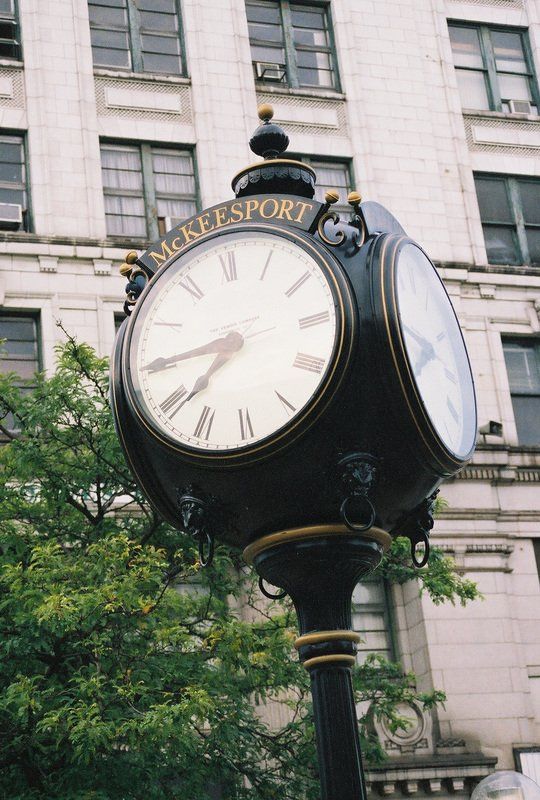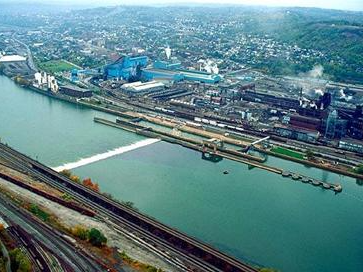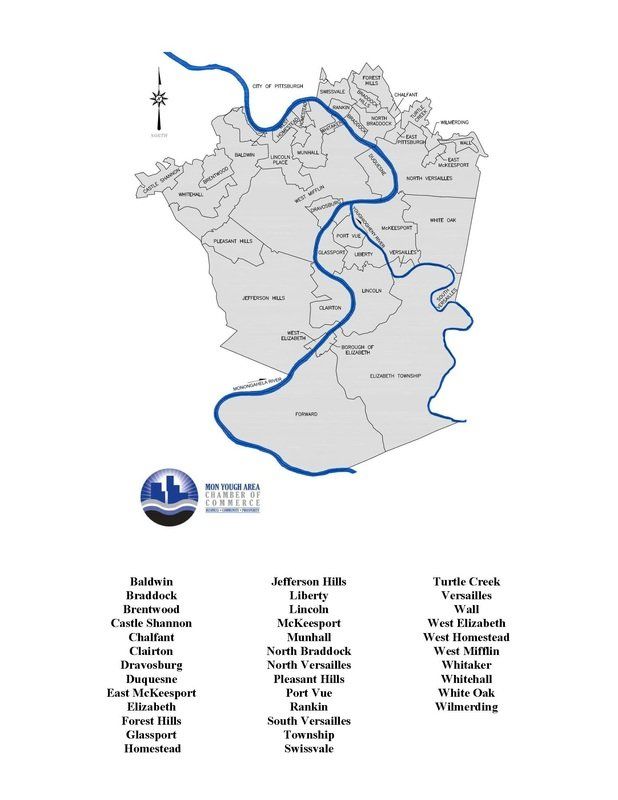Our Community
Area at a glance
The Mon Yough Area Chamber of Commerce serves the businesses along the Monongahela River and in the Turtle Creek Valley communities. From West Jefferson in the west and White Oak in the east, our region spans a long stretch of land that includes a wide variety of over 30 municipalities, from small urban cities to rural farmland.
The region we serve is a beautiful, scenic area following the Monongahela River, with its high banks and panoramic views. Additionally, the Monongahela and Youghiogheny river valleys boast of continuously expanding bike and walking trails, marinas, golf courses, amusement parks and many opportunities for water sports.
The Mon Yough Area is home to Allegheny County Regional Airport, Pennsylvania's fifth busiest airport. Conveniently located just minutes away, the airport is popular among business travelers because it's much closer than traveling to the Pittsburgh International Airport. Another great asset of the area is the Palisades Exhibition Center. Located next to the McKee's Point Marina, in the heart of the city's waterfront district, this entertainment venue is great for corporate meetings, conventions, wedding parties, concerts and special celebrations.

Our Economy

The southwestern Pennsylvania region has long been an ideal industrial hub, staying true to its reputation of being “very convenient for building” as scribbled in George Washington’s journal centuries ago. Over the last few decades, the region has shown the world how to successfully transition from a heavily industrial economy to a newly diversified one based on health care, research, and technological advancements. Today the region features a population of 2.6M people and a Gross Regional Product of $131B. It has been given high accolades such as “One of the Top 10 Most Friendly Cities to Do Business” (KPMG LLP), “U.S. Cities with the Fastest Growing Job Markets” (The Atlantic Cities), and one of the “Economically Strongest U.S. Metros” (The Brookings Institution). The southwestern PA region is home to the world headquarters of fourteen Fortune 1000 companies, one of which (Wabtec Corporation) is found directly in the Mon Yough Area. TMS International, a billion-dollar privately held company, also calls the Mon Valley home.
Major Industries and Commercial Activity
“(1753) As I got down before the Canoe, I spent some Time in viewing the Rivers, & the Land in the Fork, which I think extremely well situated for a Fort; as it has the absolute Command of both Rivers. The Land at the Point is 20 or 25 feet (7.6 m) above the common Surface of the Water; & a considerable Bottom of flat well timber'd Land all around it, very convenient for Building.”
The region has undergone quite the evolution throughout its history. The “settlement between the rivers” was a popular battleground during the French and Indian War, being the location of the Battle of the Monongahela. Soon thereafter, the region became a player in the boat building industry. By the end of the 18th century, coal deposits on Mount Washington helped Pittsburgh become an industrial powerhouse. Westinghouse Electric provided electrical infrastructure for the entire country in the 19th century. Today, the area’s economy is grounded in five strategic sectors, namely Advanced Manufacturing, Information Technology, Energy, Financial & Business Services, and Healthcare & Life Sciences. Together these sectors accounted for almost $700M in capital investment and over 5,000 new jobs in 2014.
The strategic sectors feature a mix of Pittsburgh’s historical and modern industries. Advanced manufacturing has a rich tradition in the region, spanning over a century. Today there are over 96,000 skilled workers specializing in areas such as advanced materials, electrical equipment, nanotechnology, and specialty chemistry. Andrew Carnegie constructed his first steel mill, Edgar Thomson Steel Works, in the Mon Yough community of Braddock, PA; a critical component in the region’s still important metals industry. Although the Marcellus Shale gets the most attention, the southwestern PA region’s energy history dates back centuries. Today, the region has emerged as the new center of American energy. The region features ample natural resources, $1B in R&D funding, and the country’s only private coal R&D facility in Consol R&D Center. Financial & Business Services was the largest industry contributor to the Gross Regional Product at 23% in 2014. The sector has a history dating back 150 years as a major center for corporate headquarters and support offices. Furthermore, half of all U.S. bank deposits are located within 500 miles of Pittsburgh. Information technology is bolstered by synergy between corporate R&D and the region’s world class institutions such as Carnegie Mellon University and the University of Pittsburgh. The sector features nearly 1,600 tech firms and $1.8 billion in venture capital investment since 2003. The final strategic sector, Healthcare & Life Sciences, presents a vast array of assets. The region houses over 5,500 companies within this sector, invests over $750M in annual life sciences academic R&D, and receives $450M in annual NIH funding.
The southwestern PA region has enjoyed three consecutive years of overall employment growth, climbing up to a record high of 1,161,100 jobs in 2014. The mining and logging industry, driven heavily by the Marcellus Shale, saw a one-year 10.6% growth rate; almost three times the national growth rate of 3.9%. Professional, Scientific, and Technical Services also outperformed the nation in 2014. Education and Health Services is the region’s largest employment sector at 241,400 jobs, followed by Trade, Transportation and Utilities at 216,000 jobs. Looking back at the last decade, Pittsburgh has once again shown its trademark resiliency by outperforming the national average by 0.5% for total employment since the “Great Recession.” Mining and Logging led the way with a 141.7% increase since 2007.
Whether it’s the area’s diversified economy, technological advancements, or consistent resiliency, the southwestern PA remains a premier spot for businesses and families alike.
Our History
GEORGE WASHINGTON SLEPT HERE
From TubeCityOnline by Jason Togyer
George Washington slept here. So did a Pulitzer Prize winning playwright (Marc Connelly), two Olympic gold medalists (Rich Krivda and Swin Cash), a Miss America (Henrietta Leaver), an R&B pioneer (Art Rupe) and the first female airline pilot (Helen Richey).
Many great Americans were born and raised right here in McKeesport ... though Washington wasn’t one of them. He did, however, visit twice. On his first trip to McKeesport in 1753, Washington met with Queen Allequippa, leader of the local Native Americans. Two years later, Washington and other British and colonial soldiers camped along what’s now known as Lincoln Way as they prepared to battle the French for control of the Ohio Valley. (The battle didn’t go well, to say the least.)
‘McKee’s Port
McKeesport’s history isn’t filled with military battles. In fact, things were downright sleepy until David McKee and his son, John, built a log cabin and established a ferry-boat service along the Monongahela and Youghiogheny rivers in 1769. In 1795, the McKee family founded a village they named for their ferry operation (“McKee’s Port”).
‘McKee’s Port
McKeesport’s history isn’t filled with military battles. In fact, things were downright sleepy until David McKee and his son, John, built a log cabin and established a ferry-boat service along the Monongahela and Youghiogheny rivers in 1769. In 1795, the McKee family founded a village they named for their ferry operation (“McKee’s Port”).
The village soon had a doctor, a blacksmith, a sawmill and a saloon. (Imagine a “Wild West” town, but with rivers and trees instead of cactuses!) The town really grew after coal mines were opened here in 1830. Iron furnaces needed coal and water, and since McKeesport had plenty of both, the city's first foundry opened in 1851. From iron, workers also made steel. In 1857, the railroad arrived, enabling McKeesport factories to ship products around the world.

‘The Tube City’
Pretty soon, McKeesporters were turning steel into all sorts of useful things—especially pipes. In 1872, the National Tube Works Company was founded to make steel and iron pipes (or “tubes”) for water, oil and gas. In 1901, “National Tube” became part of the new U.S. Steel Corporation and McKeesport was making more steel pipe than any other city in the world. (That’s why they still call this “The Tube City.”) Soon more industries came to town. The city’s population boomed to 55,000 during World War II, when McKeesport’s factories employed more than 10,000 people making bombs, airplane parts and other vital defense supplies.
In the 1970s and ‘80s, the decline of the U.S. steel industry hurt McKeesport and other cities in Western Pennsylvania. Today, McKeesport’s population is one-third of its peak, and because of that, empty buildings and high unemployment are familiar problems.
Down, Not Out
Although McKeesporters have been beaten up, they haven’t given up. The legacy of the city’s great past includes historic landmarks and institutions such as the Carnegie Library and Renziehausen Park and its rose garden, the second-largest in Pennsylvania. McKeesport has its own community theater, symphony orchestra and art group, along with vibrant sports leagues with teams for adults and kids.
New institutions also make McKeesport proud. Propel McKeesport charter school was recently named the best in the United States. The McKees Point Marina has revived the “port” that the McKees founded more than 200 years ago. And visitors from around the world now pass through McKeesport on the Great Allegheny Passage bike trail between Pittsburgh and the East Coast.

Mon Yough Area Chamber of Commerce
4304 Walnut Street McKeesport, PA 15132
Phone: 412-678-2450 Fax: 412-678-2451
Mon Yough Area Chamber of Commerce
